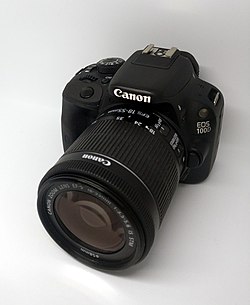 | |
| Overview | |
|---|---|
| Maker | Canon Inc. |
| Type | Digital single-lens reflex camera |
| Lens | |
| Lens mount | Canon EF |
| Lens | Interchangeable (EF / EF-S) |
| Sensor/medium | |
| Sensor type | CMOS |
| Sensor size | 22.3 × 14.9 mm (APS-C format) |
| Maximum resolution | 5184 × 3456 (18.0 effective megapixels) |
| Film speed | 100 – 12800 (expandable to H: 25600) |
| Storage media | SD/SDHC/SDXC card (UHS-I bus supported) |
| Focusing | |
| Focus modes | Evaluative, Partial, Spot, Centre-weighted Average |
| Focus areas | 9 AF points, 1 cross type (center) |
| Exposure/metering | |
| Exposure modes | Scene Intelligent Auto, Flash Off, Creative Auto, Portrait, Landscape, Close-up, Sports, Special Scenes (Night Portrait, Handheld Night Scene, HDR Backlight Control, Kids, Foods, Candlelight), Program AE, Shutter priority AE, Aperture priority AE, Manual Exposure, Movie |
| Exposure metering | Full aperture TTL, 63 zones iFCL SPC |
| Metering modes | Evaluative, Partial, Spot, Centre-weighted Average |
| Flash | |
| Flash | E-TTL II auto-pop-up built-in / External |
| Flash bracketing | Yes, with external flash |
| Shutter | |
| Shutter | Electronic focal-plane |
| Shutter speed range | 1/4000 sec. – 30 sec. and Bulb; X-sync at 1/200 sec. |
| Continuous shooting | 4.0 fps for 28 JPEG frames or for 7 RAW frames |
| Viewfinder | |
| Viewfinder | Eye-level pentamirror with 95% coverage and 0.87x magnification / LCD (Live View) |
| Image processing | |
| Image processor | DIGIC 5 |
| White balance | Auto, Daylight, Shade, Cloudy, Tungsten, White Fluorescent, Flash, Custom |
| General | |
| LCD screen | 3.0" (7.7 cm) Clear View II colour TFT touchscreen LCD with 1,040,000 dots |
| Battery | Lithium-Ion LP-E12 rechargeable |
| Dimensions | 116.8 mm × 90.7 mm × 69.4 mm (4.60 in × 3.57 in × 2.73 in) (W x H x D) |
| Weight | 407 g (14.4 oz) (CIPA standard) |
| Made in | Taiwan / Japan |
| Chronology | |
| Successor | Canon EOS 200D |
The Canon EOS 100D, known as the EOS Rebel SL1 in the Americas and EOS Kiss X7 in Japan, is an 18.0-megapixel digital single-lens reflex camera announced by Canon on 21 March 2013. [1] It has been described as the "world's smallest and lightest DSLR camera", either currently in production [2] or in the APS-C format. [3] Canon uses a smaller version of the APS-C sensor format than some other manufacturers including Nikon, Pentax, and Sony, with a crop factor of 1.6 rather than 1.5. It weighs 407 grams including battery and memory card. [4]
Contents
The successor of the EOS 100D is the EOS 200D.